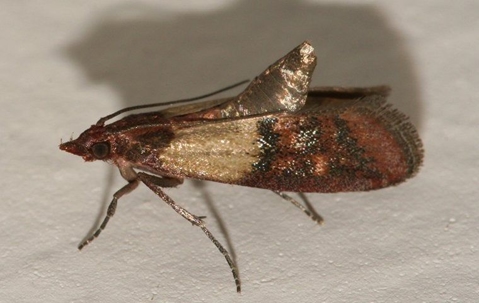Pantry moths are a common pest that invades your food and food storage areas. They lay their eggs in food sources, and when they hatch, the larvae eat the food. As they do, they contaminate it with feces and saliva, making the food inedible.
In this handy guide, you’ll learn what pantry moths look like, what might attract them to your home, how they’re getting into your home, and how to get them out of your house for good. We’ll give you a sneak peek at that last one: You need to call a professional Anaheim pest control company like A-1 Bonded Termite.
What Do Pantry Moths Look Like?
The most common pantry moth is the Indian meal moth. Its wing span is about 3/4 of an inch. Full grown, they are 1/2 to 5/8 of an inch. Their forewings are reddish-brown with a copper color on the outer 2/3. They are whitish-grey on the inner body.
Pantry moth eggs are tiny, grayish, and laid in clusters of up to 400 at a time. When they hatch 2 to 14 days later, they become pale pink, green, or yellow larvae with brown heads. They’re very active and move quickly, staying in this stage of life for 40 to 210 days.
The larvae spin webs around themselves, sometimes in food, sometimes nearby, and emerge as pupae. The pupal stage lasts between 4 and 33 days. They’re 1/4 inch long and brown. After the pupal stage is complete, they develop into adult moths 1 to 19 days later. Adults only live about 5 to 25 days.
Since they’re in the larval stage for the longest amount of time, you can learn how to get rid of larvae by partnering with A-1 Bonded Termite for their professional help.
What Could Be Attracting Pantry Moths To My House?
Pantry moths may enter your home after being attracted to your porch light or the light shining through your windows. However, you have to differentiate between types of moths that are flying around out there.
When you consider pantry moths vs. clothes moths, they both have the same attraction to light, but once they’re in your home, they act quite differently. Clothes moths prefer the dark and derive their nutrition from the natural fibers in clothing. Pantry moths prefer light in pantries or kitchens and feed on dry goods.
If you want to be sure of which type of moth you have in your house, you can tell by their appearance. Clothes moths are about half an inch long and either beige or buff colored. Their wings have hairs on the ends, making them look like feathers. Pantry moths are small moths with bronze or dark grey wings and a yellow-grey upper half.
How Are Pantry Moths Getting Into My House?
First, many pantry moths come into your home in the groceries you purchase. Warehouses may have infestations without knowing it, and they may accidentally dump eggs or larvae into the flour, cereal, nuts, dried fruits, and chocolate you bring home. Pet food, dried flowers, and spices are also at risk of having pantry moths.
Moths can also enter after being attracted by the light through holes in door or window screens, cracks in or around window and door frames, holes in window flashing or door sweeps, or whenever windows or doors are open.
Finding a pantry moth nest in your pantry is disconcerting, but if you’ve accidentally eaten contaminated food, you shouldn’t worry. You’re not going to get sick from the food, the webbing, or even the larvae. You may feel disgusted or even nauseated at the thought, but consuming the pantry moth in any of its forms will not make you ill.
How Can I Get The Pantry Moths Out Of My Home For Good?
The pantry moth life cycle is short, but they can contaminate a fair amount of food in your pantry and kitchen cabinets during that time. If you find infested food, you should put it into sealable bags and toss it into the freezer for a few days to kill off the eggs and larvae. Then safely throw the bags away in your outside garbage receptacles, knowing there won’t be any more moths coming inside from those sources.
The second thing to keep your Anaheim home free from pantry moths is to give your pantry and cabinets a good cleaning with hot, soapy water, making sure you get into all the corners and even into the hinges. If it helps, vacuum first and then wash with soap and water. This will help clear out any pupae that may be hiding.
The third thing to do is to call A-1 Bonded Termite for help. With our 46 years of experience, we’ve tangled with pantry moths a time or two. We know how to get the pantry moths out of your house for good. Contact us today for your free inspection and to learn more about our residential and commercial pest control services in Anaheim.

